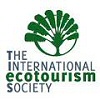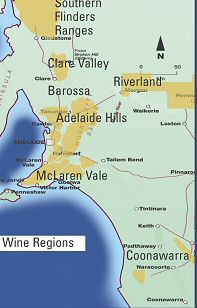Australian Natural AdventuresWildlife, Nature & Soft Adventure ToursCustom
Australia, New Zealand & Pacific tours and travel
There are more than 240 cellar doors in South Australia, and most are located within a two hours drive of Adelaide - whether you're behind the wheel, or your tour driver. There are B&Bs, small inns, and luxury retreats dotted through the seventeen wine regions, making a few days' visiting a most pleasurable way to see the state. If your time is short, or you want to get in some advance education, the National Wine Centre in Adelaide is the place to start, and there are innumerable wine stores from which you can make a selection from knoweledgeable staff. Whichever way you prefer, getting familiar with South Australian wine is a must during your visit. We've given a brief overview of some of South Australia's better known, and most accessible wine regions, below. If there's a favorite wine you'd like to find during your stay, let us know,and we'll tell you where the winery is. We've also provided links (click on the region's name) to the regions so you can do your own sleuthing. Enjoy!
The Barossa is Australia's best-known and most important wine region and is home to some of the most famous wine companies in the world including, Jacobs Creek, Penfolds and Wolf Blass. Just one hour's drive north of Adelaide, this picturesque and compact wine region contains more than 60 wineries and cellar doors, from small family enterprises to national companies. The region was originally named Barrosa by Colonel William Light, who surveyed the region, after the site of a victory by the English over the French in the Spanish Peninsula War. Misspelling on later maps gave it the unique Australian name, Barossa. The main red varieties grown in the Barossa are Shiraz, Cabernet Sauvignon and Grenache, while the key white grape varieties are Riesling, Semillon and Chardonnay. Shiraz has pride of place in the region because this is the birthplace of one of the world's great wines – Penfolds Grange. Food is central to any winemaking culture and the Barossa is no exception. The local butchers and bakers clearly show their German past with delicious smoked hams and sourdough breads. Also flourishing are the old traditions of pickling and preserving, and specialty dried fruits and glazed nuts. Suggested try-me wine: Grant Burge Abednego Shiraz Grenache Mouvedre The Clare Valley produces some of Australia's premier cool climate wines, with a national and international reputation for quality and character. Settlers from England, Ireland and Poland first moved into the Clare Valley during the 1840s producing a rich heritage of architecture and villages, which remain largely intact. Many of these buildings now serve as guesthouses, premium restaurants and galleries. There are more than 40 cellar doors in and around the five valleys. Cellar doors really are the best places to learn about wine and the friendly staff love nothing more than guiding visitors through the range of wines on offer. They also enjoy sharing the history and stories of the wineries and the region. And with the hands-on nature of boutique wineries, you will sometimes find the winemakers themselves behind the cellar door counter. Suggested try-me wine: Kilikanoon Oracle Shiraz Although not nearly as well known as the other wine regions in the state, the warm and sunny Riverland is actually the largest wine-producing region in Australia, accounting for around 30% of the total wine production of Australia and 60% of South Australia's production. Home to Australia's largest winery, Hardy Wine Company's Berri Estate, and wine companies large and small, the Riverland has a growing number of cellar doors that offer tastings of a wide range of wines. It is also the home to Banrock Station, which in addition to a well-known wine brand is an eco¬tourism project between Hardy Wines and Wetlands Australia to replenish the Murray River's wetlands with birdlife, native fish and flora. Suggested
try-me wine:Salena
Estates Chardonnay (taste warning: this is a mildly oaked buttery
style) Standing at the gateway to the Fleurieu Peninsula with around 50 cellar doors is McLaren Vale. It is the place for bold shiraz, elegant cabernet sauvignon and some of the best chardonnay in Australia. John Reynell planted the region's first grapes in 1838 at Reynella, where he employed a young laborer named Thomas Hardy and laid the foundations to two dynasties that would, dominate the region for more than a century. Some of the cellar doors seemed to have not changed much; Tatachilla still reeks of history and still looks like a good old-fashioned winery and so to does Hardy's Tintara. Others have moved, with the times such as d'Arenberg with its splendid cellar door and restaurant lip and there is also a constantly growing new generation of small wineries such as Chapel Hill Winery. The region also has fantastic food, visitors will find themselves exposed at every turn to roadside outlets selling jams, relishes, hand-made breads, traditional cured and smoked meats, rich cheese and much more. Suggested try-me wine: Pirramimma Petit Verdot The Coonawarra wine region was founded in 1891 by Scottish settler John Riddoch, who realized the potential of its rich, red soils. Today these soils yield some of the best wine grapes in the world. The terra rossa soil sitting atop deep limestone beds along a cigar shaped strip of land, has led to Coonawarra's vineyards becoming the most sought after in Australia. Described as the ‘Bordeaux of Australia,' the climate is also significant, with cold, wet winters, warm summers and a long ripening season. Cabernet Sauvignon is the main wine of the region, comprising over 50% of its vineyard plantings. Suggested try-me wine: Majella Malleea Coonawarra Cab/Shiraz The Adelaide Hills is one of Australia's premier high altitude wine regions, with the region's major grape varieties including chardonnay, pinot noir, sauvignon blanc and shiraz. A diverse range of climatic zones have enabled, the region's winemakers to produce subtle variations in wines and the steep slopes of many of the region's vineyards make hand-pruning and picking a necessity. There are now 26 cellar doors in the region ranging from more well-known names such as Petaluma and Nepenthe to small, family run vineyards. Suggested
try-me wine: Nepenthe
Sauvignon Blanc
|






